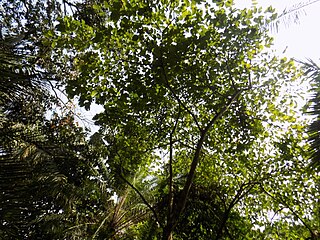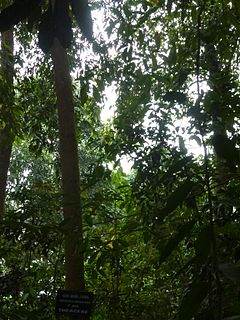
Inia is a genus of river dolphins from South America. It contains one to three species.

Bauhinia is a large genus of flowering plants in the subfamily Cercidoideae and tribe Bauhinieae, in the large flowering plant family Fabaceae, with a pantropical distribution. The genus was named after the Bauhin brothers Gaspard and Johann, Swiss-French botanists.

Salesópolis is a municipality in the state of São Paulo in Brazil. It is part of the Metropolitan Region of São Paulo. The population is 17,252 in an area of 424.997 km². Salesópolis sits at an elevation of 850 metres (2,790 ft). It is noted for being the source of the Tietê River.

Bauhinia forficata, commonly known as Brazilian orchid tree, pata-de-vaca,, pezuña de vaca is a species of flowering tree in the pea family, Fabaceae, that is native to Argentina, Brazil, Uruguay and Peru.

The big red bat is a species of vesper bat from South and Central America.

Bokermann's nectar bat is a bat species from South America. It is endemic to Brazil. It feeds on nectar, and is listed as an endangered species.

Dekeyser's nectar bat is a bat species from South America. It is found in Brazil and Bolivia.
Bauhinia augusti is a species of legume in the family Fabaceae. It is found only in Peru.

Bauhinia bowkeri is a species of legume in the family Fabaceae. It is found only in South Africa, where it is threatened by habitat loss.
Bauhinia flagelliflora is a species of legume in the family Fabaceae. It is found only in Ecuador. Its natural habitat is subtropical or tropical moist montane forests.
Bauhinia haughtii is a species of legume in the family Fabaceae. It is found only in Ecuador. Its natural habitats are subtropical or tropical moist lowland forests and subtropical or tropical moist montane forests.
Bauhinia mombassae is a species of legume in the family Fabaceae. It is found in Kenya and Tanzania. It is threatened by habitat loss.
Bauhinia seleriana is a species of legume in the family Fabaceae. It is found from central and southern Mexico to Honduras.
Bauhinia pichinchensis is a species of legume in the family Fabaceae. It grows as a tree reaching 10 m in height. It is found only in Ecuador. Its natural habitats are subtropical or tropical moist lowland forests and subtropical or tropical moist montane forests.

Bauhinia picta, known as the algodoncillo, casco de vaca, palo de orquídeas, or pata de vaca, is a species of legume in the family Fabaceae. It is found in Colombia, Panama, and Venezuela.
Bauhinia seminarioi is a species of legume in the family Fabaceae. It is found only in Ecuador. Its natural habitat is subtropical or tropical dry forests.
Bauhinia stenantha is a species of legume in the family Fabaceae. It is found only in Ecuador. Its natural habitat is subtropical or tropical dry shrubland.

Adinandra integerrima is a species of plant in the Pentaphylacaceae family. It is found in Malaysia and Singapore. It is threatened by habitat loss.
Oligoryzomys rupestris is a species of rodent in the genus Oligoryzomys of family Cricetidae. It is known only from eastern Brazil, where it has been found in several localities in the campos rupestres montane savanna ecoregion. This is a small Oligoryzomys species with a gray head, a yellow-brown back and gray belly and tail. Of the two karyotypic forms described by Silva & Yonenaga-Yassuda in 1998, species 1 is probably identical to O. rupestris, while the other is closely related. Its karyotype has 2n = 46 and FNa = 52.

Lysiphyllum cunninghamii is a species of plant in the family Fabaceae. It is native to northern Australia where it occurs from Western Australia through the Northern Territory to Queensland.











